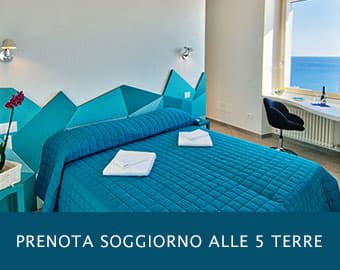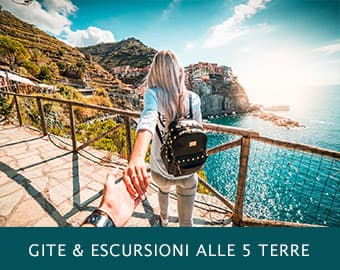Recommended
by CinqueTerre.com
 Sestri Levante (GE) is the center of the Ligurian Riviera, convenient for reaching the coastal villages such as Moneglia, Deiva Marina, Bonassola, Levanto and the Cinque Terre. For its conformation it is also called the "city of the two seas", which is the historical center and the junction on a first isthmus ending with a rocky promontory of the writer Hans Christian Andersen who stayed in Sestri Levante in 1833 and from which he won the famous Andersen Festival and Award), and "del Silenzio", a protagonist all over the world for its beauty. Passages in the historic center among typical carruggi and Ligurian monuments bearing characteristic slate portals.
Sestri Levante (GE) is the center of the Ligurian Riviera, convenient for reaching the coastal villages such as Moneglia, Deiva Marina, Bonassola, Levanto and the Cinque Terre. For its conformation it is also called the "city of the two seas", which is the historical center and the junction on a first isthmus ending with a rocky promontory of the writer Hans Christian Andersen who stayed in Sestri Levante in 1833 and from which he won the famous Andersen Festival and Award), and "del Silenzio", a protagonist all over the world for its beauty. Passages in the historic center among typical carruggi and Ligurian monuments bearing characteristic slate portals.
 In ancient times for Sestri Levante was meant the islet that today corresponds to the promontory where the marina was built. Only in modern times was it joined to the mainland by a thin strip of land formed by the floods of the Gromolo stream and the constant action of the sea. During the Roman age "Segesta Tigulliorum" or "Segeste" became an important maritime and commercial port inland thanks to the presence of the nearby Bracco pass. In the Lombard period, monasticism developed with the monks of Bobbio who went to the sea to the area of ??Moneglia and throughout the Ligurian Levant, which gave rise to numerous farms and monastic cells. Declined during the period of the barbarian invasions, the village resumed its commercial activities and expanded in the Middle Ages. In 1070 Sestri Levante, like the other villages of Tigullio, was involved in the naval clashes between the Maritime Republics of Genoa and its rival Pisa, through the alternate domination of the local Malaspina and Fieschi families, to fall definitively within the political orbit of the Republic of Genoa.
In ancient times for Sestri Levante was meant the islet that today corresponds to the promontory where the marina was built. Only in modern times was it joined to the mainland by a thin strip of land formed by the floods of the Gromolo stream and the constant action of the sea. During the Roman age "Segesta Tigulliorum" or "Segeste" became an important maritime and commercial port inland thanks to the presence of the nearby Bracco pass. In the Lombard period, monasticism developed with the monks of Bobbio who went to the sea to the area of ??Moneglia and throughout the Ligurian Levant, which gave rise to numerous farms and monastic cells. Declined during the period of the barbarian invasions, the village resumed its commercial activities and expanded in the Middle Ages. In 1070 Sestri Levante, like the other villages of Tigullio, was involved in the naval clashes between the Maritime Republics of Genoa and its rival Pisa, through the alternate domination of the local Malaspina and Fieschi families, to fall definitively within the political orbit of the Republic of Genoa.
Sestri Levante what to see
 Bay of Silence: for centuries it has been a source of inspiration for writers and intellectuals such as Hans Christian Andersen, Richard Wagner, the scientist Gugliemo Marconi. Houses with a colorful façade (including the Pinacoteca Galleria Rizzi) rest directly on the sand forming a crown that ends with the Convento dell'Annunziata, built in 1469 by the Dominican fathers and now used as a cultural center. In the midst of the rocks emerging from the low water you can see the bronze and life-size sculpture of the Fisherman, symbol of the city. At the opposite end, the bay closes the luxuriant Punta Manara.
Bay of Silence: for centuries it has been a source of inspiration for writers and intellectuals such as Hans Christian Andersen, Richard Wagner, the scientist Gugliemo Marconi. Houses with a colorful façade (including the Pinacoteca Galleria Rizzi) rest directly on the sand forming a crown that ends with the Convento dell'Annunziata, built in 1469 by the Dominican fathers and now used as a cultural center. In the midst of the rocks emerging from the low water you can see the bronze and life-size sculpture of the Fisherman, symbol of the city. At the opposite end, the bay closes the luxuriant Punta Manara.
 In the historic center, among alleys rich in souvenir shops, historic shops and restaurants, we find Fascie Rosse Palace (Corso Colombo), home of the Archaeological Museum and recognizable by the embattled tower, another of the symbols of the city. The Church of Santa Maria di Nazareth (Matteotti Square) has been attested since 1368 and presents a neoclassical pronaos. Inside there are paintings from the Baroque period and a wooden Pietà by Anton Maria Maragliano. The still more ancient Church of San Nicolò dell'Isola (via Penisola) dates back to 1151, in Romanesque style, with epigraphs and ancient medieval tombstones on either side. The Church of the Immaculate Conception, in the area east of the Bay of Silence, in a dominant position with the adjoining Capuchin friars convent. Sestri Levante Beaches: they are always found in the historical center. Wide, sandy, with shallow waters and equipped with every comfort in the Baia delle Favole (Descalzo seafront and Via Veneto). Mostly free in the Bay of Silence.
In the historic center, among alleys rich in souvenir shops, historic shops and restaurants, we find Fascie Rosse Palace (Corso Colombo), home of the Archaeological Museum and recognizable by the embattled tower, another of the symbols of the city. The Church of Santa Maria di Nazareth (Matteotti Square) has been attested since 1368 and presents a neoclassical pronaos. Inside there are paintings from the Baroque period and a wooden Pietà by Anton Maria Maragliano. The still more ancient Church of San Nicolò dell'Isola (via Penisola) dates back to 1151, in Romanesque style, with epigraphs and ancient medieval tombstones on either side. The Church of the Immaculate Conception, in the area east of the Bay of Silence, in a dominant position with the adjoining Capuchin friars convent. Sestri Levante Beaches: they are always found in the historical center. Wide, sandy, with shallow waters and equipped with every comfort in the Baia delle Favole (Descalzo seafront and Via Veneto). Mostly free in the Bay of Silence.
 Sestri Levante Paths: the promontories of Sestri Levante are full of hiking trails that offer spectacular views. One of them starts from Vico del Bottone in the historic center and leads to Punta Manara. Once you reach the ancient ruined lookout tower, set in a splendid panoramic position, you go down to Riva Trigoso between houses and cultivated fields. The path of the Rocche di S.Anna starts in the locality of "Pietra Calante", along the ancient Roman road that crosses the steep cliff (Rocche di Sant’Anna) and reaches Cavi di Lavagna. The Slate Cicovia is a path without excessive differences in height: starting from Sestri Levante, with the SS1 Via Aurelia in the north-east direction, you reach the Lavagna railway station (15 minutes from Sestri Levante), where the cycle route begins, between stretches of dirt road, white road and asphalt.
Sestri Levante Paths: the promontories of Sestri Levante are full of hiking trails that offer spectacular views. One of them starts from Vico del Bottone in the historic center and leads to Punta Manara. Once you reach the ancient ruined lookout tower, set in a splendid panoramic position, you go down to Riva Trigoso between houses and cultivated fields. The path of the Rocche di S.Anna starts in the locality of "Pietra Calante", along the ancient Roman road that crosses the steep cliff (Rocche di Sant’Anna) and reaches Cavi di Lavagna. The Slate Cicovia is a path without excessive differences in height: starting from Sestri Levante, with the SS1 Via Aurelia in the north-east direction, you reach the Lavagna railway station (15 minutes from Sestri Levante), where the cycle route begins, between stretches of dirt road, white road and asphalt.
Useful information
How to get to Sestri Levante:
- Car: from the A12 Genoa-La Spezia, exit at Sestri Levante. The city center is about 1 km from the exit. Sestri Levante is also crossed by the SS1 Aurelia.
- Train: Genoa - La Spezia line, Sestri Levante train station with regional and Intercity train stops.
- Boats: lines managed by the Tigullio Maritime Service
Parking: Sant'Anna car park (after the tunnel from Cavi di Lavagna), FS station car park, Giovanni Falcone car park and Paolo Borsellino car park, parking along Via Aurelia and near the swimming pools and municipal park.
Tourist Information Office: ground floor of Fascie on Corso Palace in Largo Colombo 50, Tel. 0185 478530, E-mail iat@comune.sestri-levante.ge.it





